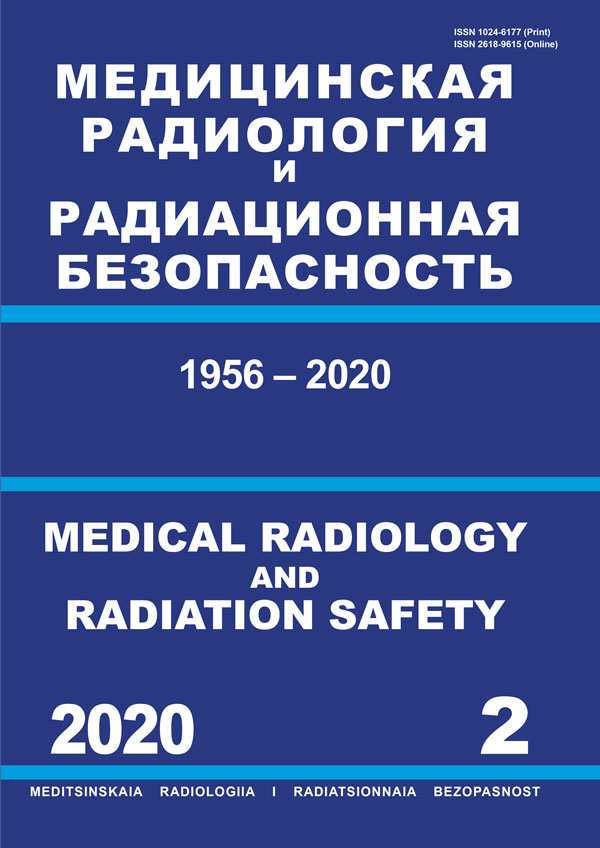Russian Federation
Russian Federation
RUDN University
MIREA - Russian Technological University
Moscow, Moscow, Russian Federation
Russian Federation
CSCSTI 76.03
CSCSTI 76.33
Russian Classification of Professions by Education 14.04.02
Russian Classification of Professions by Education 31.06.2001
Russian Classification of Professions by Education 31.08.08
Russian Classification of Professions by Education 32.08.12
Russian Library and Bibliographic Classification 51
Russian Library and Bibliographic Classification 534
Russian Trade and Bibliographic Classification 5708
Russian Trade and Bibliographic Classification 5712
Russian Trade and Bibliographic Classification 5734
Russian Trade and Bibliographic Classification 6212
Purpose: Analysis of the dependence of the probability of death due to radiogenic cancer on the dose level, on the nature of exposure to ionizing radiation (IR), on age when exposed to IR and on the age of its effect, etc., to support decisions on medical and social measures to protect workers in hazardous industries. Material and methods: Calculation formulas for risk assessment are given using the multiplicative and additive risk models for one-time and extended exposure to IR. Medical and demographic data for the urban population of the Chelyabinsk region for 1989 were taken as necessary baseline data for risk assessment. The risk was calculated using the combined BEIR VII and EPA models. Results: The risk is calculated in terms of annual or lifetime risk of death from spontaneous and radiogenic solid cancer for two scenarios of occupational exposure to IR (single and extended), for a set dose of 0.5; 1; 2 Sv and different ages of survival of a person who started work in production at the age of 20. Conclusions: 1. For small and moderate doses (D ≤ 1 Sv), prolonged exposure in the age range of 20–30 years leads to less risk than with short-term exposure at the age of 20 years with the same dose. This effect is absent for irradiation after 30 years. 2. The risk of death from spontaneous solid cancer is somewhat less for exposed people than for non-exposed people. Reason: radiogenic cancer begins to compete with spontaneous one. 3. With relatively small integral doses (< 1 Sv), the radiogenic risk linearly depends on the dose. At moderate and high doses (≥ 1 Sv), for continuous extended exposure the dose dependence becomes nonlinear. 4. The probability of causation of death from radiogenic solid cancer for older people and for doses of D ≥ 1 Sv becomes significant, especially for women (30 % and more in relation to spontaneous solid cancer). 5. The lifetime risk of radiogenic cancer from the dose received at working age decreases significantly with age when it reaches 60 years of age.
dose, occupational exposure, risk assessment, radiogenic risk, mortality, solid cancer, dose–response relationship
1. Soloviev VYu, Demin VF, Krasnyuk VI. Algorithm of decision making on social and medical protection in an emergency. Gygiena and Sanitaria. 2019;98(1):33-5. (in Russ.)
2. [Demin VF, Biryukov AP, Zabelin MV, Soloviev VYu. Problems of identifying dose - effect dependence for ionizing radiation. Medical Radiology and Radiation Safety. 2018;63(3):25-33. (in Russ.)
3. Rakhmanin YuA, Demin VF, Ivanov SI. General approach to the assessment, comparison and normalization of the risk to human health from various sources of harm. Bulletin of the Russian Academy of Medical Sciences. 2006;4:5-8. (in Russ.)
4. Demin VF, Zakharchenko IE. The risk of exposure to ionizing radiation and other harmful factors on human health: assessment methods and practical application. Radiation Biology. Radioecology. 2012;52(1):77-89. (in Russ.)
5. Recommendations of the International Commission on Radiological Protection. ICRP Publication 103. Ann. ICRP. 2007;37(2-4).
6. United Nations Scientific Committee on the Effects of Atomic Radiation. Effects of Ionizing Radiation, UNSCEAR 2006 Report, Volume I, Annex A, NY: United Nations, 2008.
7. Health Risks from Exposure to Low Levels of Ionizing Radiation (BEIRVII). - National Academy Press. - Washington DC. 2005. 710 p.
8. EPA Radiogenic Cancer Risk Models and Projections for the U.S. Population. - April 2011, U.S. EPA, Washington DC. 2011. 164 p.
9. Il’in LA, Kiselev MV, Panfilov AP. Medical and dosimetric register of nuclear industry workers in Russia. State and prospects. Bulletin of Siberian medicine. 2005;4 (2):6-13. (in Russ.)






